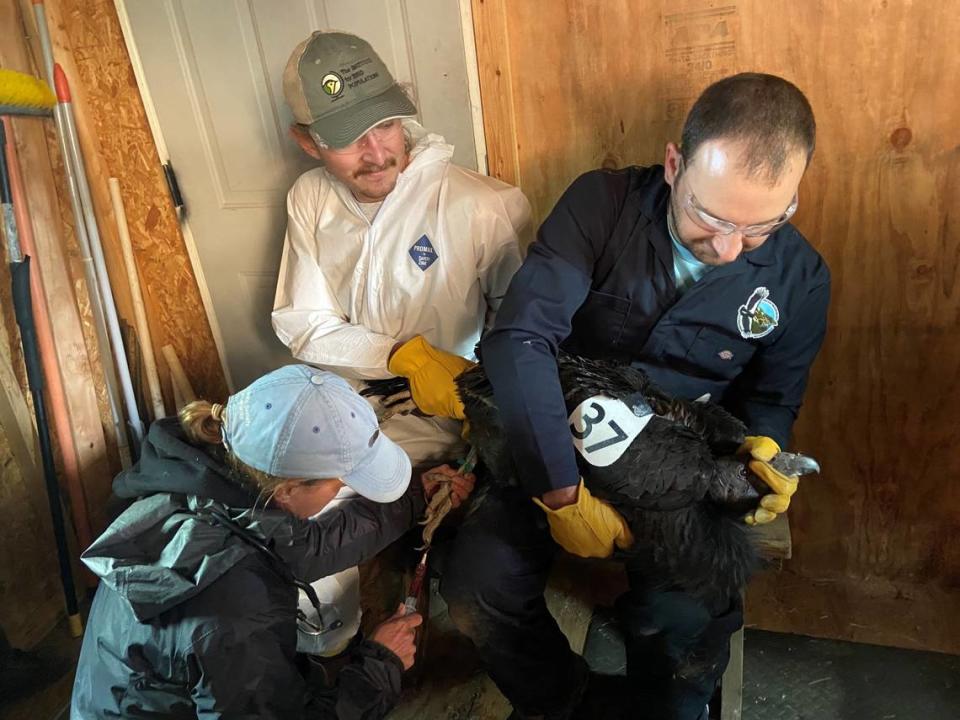10 California condors to be released into the wild. Here’s how to watch it
Ten juvenile California condors — fully vaccinated now against the Highly Pathogenic Avian Influenza (HPAI) — will be released in cohorts of five from their large holding pen in the San Simeon mountains on Nov. 28 and Dec. 12.
On Nov. 18, nine of the captive-raised juveniles, a year and a half old, received their second dose in the San Simeon holding pen from wildlife veterinarian Dr. Amy Wells.
One condor in the group, #1170, was previously given its second booster at the Los Angeles Zoo.
Before they can slip out of the open gate on the ground floor of the holding pen, and get their first taste of the wild, the six females and four males are fitted with radio and GPS transmitters, according to an email from Ventana Wildlife Society biologist Joe Burnett.
The outcome of the recent vaccine trials — black vultures passed the safety test after being twice inoculated by the U.S. Fish and Wildlife Service — was welcome news to the California Condor Recovery Program, spearheaded in Central California by the Ventana Wildlife Society.
Efforts to develop an appropriate vaccine for the 101 birds in the Central California flock were ramped up following the HPAI-related mortality of 21 condors in Arizona earlier this year.
The successful vaccine outcome extends confidence to the wildlife society that these giant, critically endangered birds with nearly ten-foot wingspans, will withstand contact with the deadly HPAI, which has killed millions of birds worldwide, notably poultry and wild birds.
In California, the HPAI is also reported to be responsible for the deaths of golden eagles, bald eagles, turkey vultures, geese, ravens, gulls, grebes and other wild birds.
Meanwhile, the Ventana Wildlife Society plans to share the livestream of the condor releases with La Paz Middle School in Salinas on Nov. 28. The Los Padres Middle School (also in Salinas) will view the release Dec. 12.
Ventana Wildlife Society — which has a “Wellness Through Nature” program for youth — will have an educator on hand for both middle schools during the releases.

New condor quarantine pens will help with outbreaks
In order to isolate and provide medical care for any condors that may become sick due to the HPAI, the wildlife society has ordered — and soon will receive — ten large steel quarantine pens.
These pens will be located on land donated by the Monterey County Society for the Prevention of Cruelty to Animals along Highway 68,. between Monterey and Salinas.
Burnett said the pens “are designed to be similar to quarantine pens at the LA Zoo.”
They are intended to treat one condor at a time, he said.
They could, however, “hold two condors in a crisis scenario, perhaps like an HPAI outbreak — or if we need to expedite vaccinating wild condors.”
On that subject, Kelly Sorenson, executive director of Ventana Wildlife Society, was asked if his group would entertain the idea of capturing — and inoculating — some or all of the 101 condors currently riding the thermals in the Central California flock.
“That’s not really a great option,” Sorenson said in a recent interview. “It’s not something (condors) would enjoy, to put it lightly. But it’s better than losing a large number of birds. We are trying to prepare for all scenarios.”
Capturing free-flying condors for inoculation is a decision that will ultimately be made by the U.S. Fish and Wildlife Service, Sorenson added.
How breeding program helped keep CA condors from extinction
Thousands of California condors once ruled the skies from British Columbia to Mexico, but the loss of habitat, hunting and poisoning nearly triggered their extinction.
Indeed, in the early 1980s the flock was reduced to approximately 22 condors nationwide. A debate raged as to whether to let them fade into history, or to capture them and launch a captive breeding program.
Fortuitously, the second option was adopted and today — thanks to the resourceful in-house breeding program — there are a reported 354 condors flying free in California, Baja, the Grand Canyon and in Idaho.
About 204 condors are being raised in several states as part of the captive breeding program, and 101 condors fly free in Central California (Big Sur, Pinnacles National Park and San Simeon).
When the ten juveniles are released this fall, the Central California flock will grow to 111 birds.
To view the releases on Nov. 28 and Dec. 12, or see the 10 juveniles in their pen, visit ventanaws.org/condor_cam.html.
To learn more about the condor program, visit ventanaws.org.

